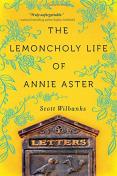BKMT READING GUIDES
The Lemoncholy Life of Annie Aster
by Scott Wilbanks
Paperback : 400 pages
11 clubs reading this now
3 members have read this book
Introduction
Annabelle Aster doesn't bow to convention-not even that of space and time-which makes the 1890s Kansas wheat field that has appeared in her modern-day San Francisco garden easy to accept. Even more peculiar is Elsbeth, the truculent schoolmarm who sends Annie letters through the mysterious brass mailbox perched on the picket fence that now divides their two worlds.
Annie and Elsbeth's search for an explanation to the hiccup in the universe linking their homes leads to an unsettling discovery-and potential disaster for both of them. Together they must solve the mystery of what connects them before one of them is convicted of a murder that has yet to happen...and yet somehow already did.
Excerpt
CHAPTERTWO
Elsbeth Grundy
March 19, 1895
A wheat field outside Sage, Kansas
Elsbeth Grundy was a loner, and an odd one at that, but company was headed her way whether she liked it or not. She lived in the plains of central Kansas, alone in a cabin that was, to use a charitable word, uncomplicated. It was an austere dwelling with a cast-iron stove, a table and chair, two cabinets, a fireplace, a rocker, and a small bedroom to the rear. Being somewhat prideful of her country habits, Elsbeth had a privy built out back, a decision she often regretted with a few choice words when the weather turned for the worse. ...
Discussion Questions
1. If you had Annie’s time portal, when and where would you go?2. Who is your favorite character? Why?
3. Imagery adds depth to the written word in literature. There are several repeating images in The Lemoncholy Life Of Annie Aster, one of which is that of a crow. What do you think the crow might represent? Did you notice any other significant images? What might they mean?
4. Roses, particularly, have been a bonanza for symbologists throughout history. What do roses represent to you? What do you think the roses in the garden that appears behind Annie’s house represent?
5. Déjà vu is defined as the illusion of having previously experienced something. Christian fears that he may have met Edmond before, but doesn’t remember. In the end, did he experience déjà vu, or was it more complicated than that?
6. As a society, we are undeniably judgmental about drug abuse. Did your impression of Edmond change when you became aware that he struggled with drug addiction? Why or why not? Do you think drug addiction is a disease or a choice?
7. Cap’n was shocked by how the world treated her when she lost her family and home. Fabian said that homelessness and poverty, made her invisible to the world, because otherwise people would have to ‘face their own pettiness.’ Do you think that is a fair comment?
8. “I’m not proud of what I done, but pride ain’t really something I can afford.” Cap’n says that after admitting to Annie that she steals, and her point is clear. While she is mindful that theft is wrong, she’s not going to suffer too many scruples over it when her survival is at stake. And that begs a moralistic question. What is the measure of this sin (stealing) when it is held up against survival? Whose sin in greater: Cap’n’s for stealing, or society’s for creating the circumstances that forced her to steal?
9. The Lemoncholy Life Of Annie Aster is, at its heart, a novel about five misfits—Annie, Elsbeth, Cap’n, Christina, Edmond—that explores the concept of marginalization through their experience. What do you think were the qualities or circumstances that led to each of the protagonists’ marginalization?
10. Edmond says, “It’s not sin, what’s inside you. I promise you, it’s not.” His comment addresses one of today’s hot-button topics—homosexuality as a sin. Is it?
11. Do you think that homosexuality is a choice? Does the fact that LGBT youth are four times as likely to attempt suicide as their heterosexual counterparts (eight times as likely if they’ve experienced rejection from their family) affect your determination as to whether or not homosexuality is a choice?
12. Does our concept of what constitutes sin evolve over time as we gain a better understanding of the forces behind it? (Example: slavery.)
13. In the novel, the author toys with the concept of fate as a physical force of the universe, not unlike gravity. Just to make things more complicated (he loves complications), he stirred in two other powerful forces—love and time—binding the three together. Which of these three forces—love, time, or fate—played the greatest role in uniting Annie and El? Which of these forces played the greatest role in uniting our other protagonists?
14. Danyer is a figment of Mr. Culler’s imagination that allows him to do evil without feeling the weight of guilt or the need to take personal responsibility for his actions. Basically, Mr. Culler blames Danyer for his own bad behavior. What are some common scenarios in which people blame others in order to deny personal responsibility today?
15. Courage and sacrifice often go hand in hand. Annie begs Christian to find his courage and be true to himself, and he does, but he has to sacrifice everything he was taught to do so. What other acts of courage did you find in the book, and what sacrifices did they require?
Book Club Recommendations
Recommended to book clubs by 3 of 3 members.
Book Club HQ to over 90,000+ book clubs and ready to welcome yours.
Get free weekly updates on top club picks, book giveaways, author events and more








